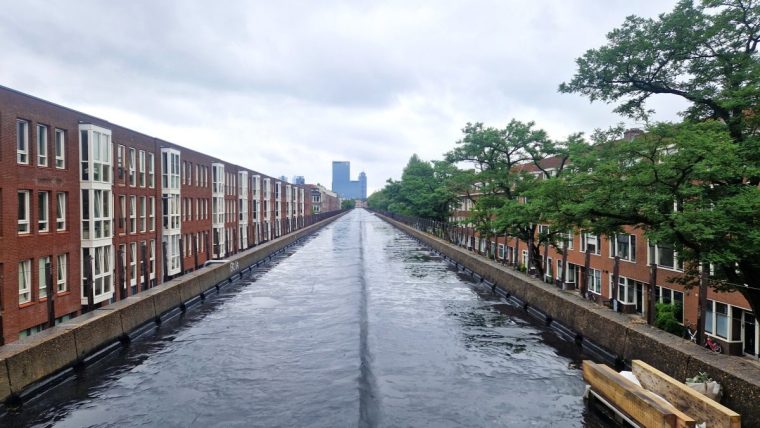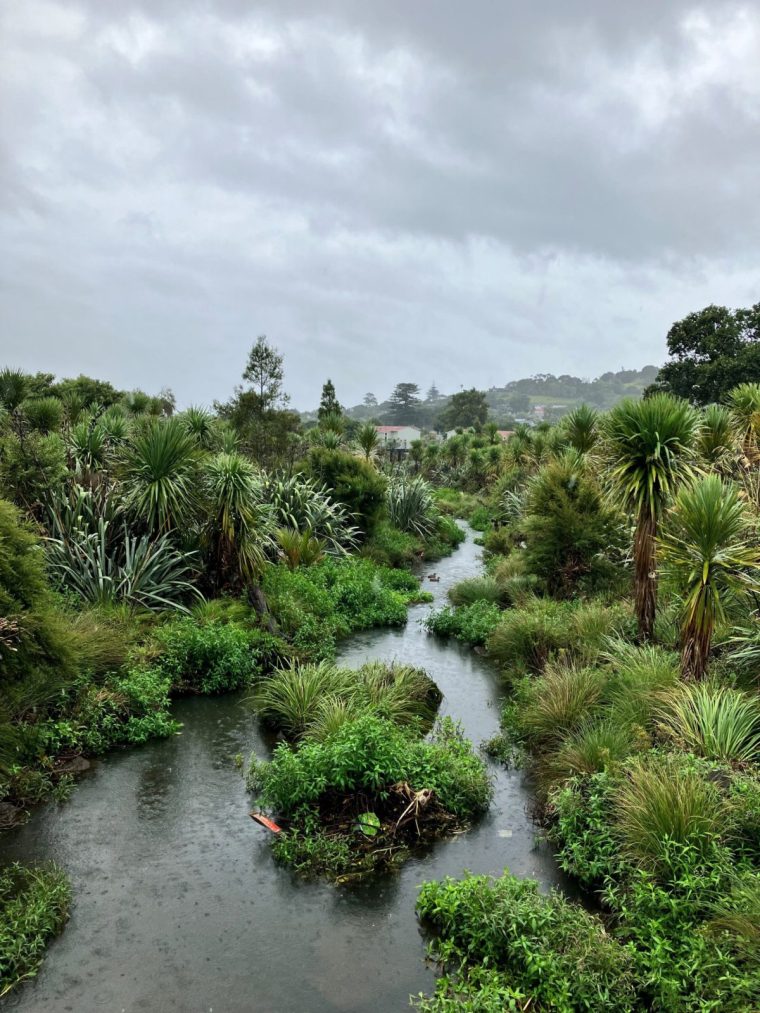It’s rush hour in Rotterdam. The city hums with traffic as workers head home, but the platform at Hofplein station is quiet, except for a few parakeets screeching overhead.
Trains no longer call at this abandoned terminus on the disused Hofplein line, which is being transformed into a park reminiscent of New York’s High Line. Where trains once ran, trees now grow; wildflower-filled planters have replaced commuters. Rotterdam’s take on the High Line will – whisper it – be superior to the original when complete in 2027. So reckons architect Dirk van Peijpe, but he’s biased – his firm, De Urbanisten, is designing it.
“I spoke to Robert Hammond [the High Line’s co-founder] and he was jealous of our plans,” beams van Peijpe. Jealous, he says, because Rotterdam’s Hofbogenpark will not just be something pretty; it will also help the city deal with storms, which are becoming more common and intense with climate change.
In a week that saw thousands of homes evacuated as thunderstorms and torrential rain battered coastal Spain again, the need for urban areas to be able to cope with excess water in a more efficient way has never been more pressing. The sponge city concept being utilised at the Hofbogenpark could provide part of the solution. It originated in China but has since spread across the globe to everywhere from Canada to Mansfield, Nottinghamshire.
In Rotterdam, rainwater falling on nearby streets will be channelled towards the park where it will be purified and stored in an aquifer. The recycled water will be pumped up on dry days to irrigate plants, refill ponds and feed fountains that children will be able to play in.
“It’s combining water management with improving public spaces,” says van Peijpe. “It’s really cool.” Rotterdam is renowned for its audacious architecture – it’s not called “Manhattan on the Maas” for nothing – but Hofbogenpark operates on a modest scale.

“It’s designed so a hedgehog can walk from one end to the other,” says van Peijpe. “It’s not just for people, but other earthlings; toads, bats, bees, butterflies. That was the other thing that made Robert Hammond jealous.”
Only a pilot section of the Hofbogenpark is open, but when the €53m park is finished, it will meander for 2km through some of Rotterdam’s most nature-deprived neighbourhoods. Hedgehogs (“if they turn up”) will access it via plant-lined ramps.
It’s one of a handful of projects designed to absorb floodwater, boost biodiversity and improve access to nature in Rotterdam. Others include wetlands, tidal parks and water squares, which have been sunk into neighbourhoods across the city. These foliage-fringed bowls retain millions of litres of rainwater, and are used as skateparks, amphitheatres and basket ball courts when it’s dry. Copenhagen and Montreal are among the cities that have copied the idea.
The movement to make cities spongier was started by the Chinese landscape architect Kongjian Yu. As a child he saved himself from drowning in a flooded river by clutching onto reeds along the bank. Altered by this experience, in the mid-2010s he pioneered the use of nature-based solutions to tackle flooding.
Many Chinese cities embraced his thinking, which is catching on globally. It needs to. The devastating floods in Spain are another reminder that our cities are ill-prepared for extreme weather. Germany, France and Italy have also been hit hard lately.

A year’s worth of rain fell in and around Valencia in a single day last month. Urban parks and water squares would have done little to stop the devastation, admits van Peijpe. “The problem didn’t start in Valencia; there was so much water coming in from outside,” he says. “We need to look on a much bigger scale. We need to go upstream and see if we can delay rainwater there.”
Like Rotterdam, Mansfield is also trying to make drainage cool. Once-drab urban wastelands in the Nottinghamshire town have been transformed into flower-filled raingardens. Concrete precincts and scruffy verges are among the spaces that have been reimagined. They’re not just nice to look at. Beneath the floral displays are layers of soil and an absorbent medium composed of natural materials that soak up rainwater.
Dozens of detention basins – giant, grass-lined bowls – have also been dug near flood-prone homes.
“They hold water for a few days after a rain event,” says Adam Boucher, who’s leading Mansfield’s £76m green drainage project for Severn Trent. “I’ve seen dragonflies buzzing around them, kestrels coming down to bathe in them – they’re a hive of activity.”
An area totalling four hectares – or 5.6 football pitches – is being converted into so-called sustainable urban drainage systems (or SuDS) in Mansfield. Together, they will retain 30 million litres of surface water – equivalent to 12 Olympic-sized swimming pools, says Severn Trent.
The firm is the Government’s top-ranked water company in England for environmental performance, despite being fined £2m for illegally discharging 260 million litres of sewage into rivers last winter. Preventing surface water from overwhelming sewers, leading to discharge, is a key motivation for Severn Trent, which has committed to maintaining the SuDS.
The company’s work in Mansfield is the largest green drainage initiative in the UK. It’s a welcome move from an industry failing to deal with the nation’s plumbing. Other companies are taking note.
“We’ve had Anglian, Yorkshire and Southern visit,” says Boucher. “We’ve learned a lot from this project, which we’ll share.”
Mansfield was chosen because it’s a flood risk, but also because, like Rotterdam, its soil retains water. Similar results will, admits Boucher, “be harder to achieve” in towns built on clay, as in neighbouring Derbyshire, where the company will soon install such systems.
Mansfield’s SuDS weren’t without objections. Some residents begrudged giving up parking spaces for raingardens.
There are other forces working against the sponge city movement, including urban densification and the fashion for paving over front gardens. Uniting landowners and stakeholders behind the cause can be challenging too, says Mark Fletcher, global water leader at Arup, a UK-headquartered engineering consultancy.
“In London, there is progress – all the key parties are getting around the table,” he says. “I think a sponge city will be created when it becomes a collective goal.”
There is “no silver bullet” to address urban flooding, cautions Fletcher, but he says there are many opportunities for cities to increase sponginess. He said: “From rooftops to car parks, there are lots of untapped opportunities.”
Sponge city top spots
Hofbogenpark, Rotterdam
Rotterdam’s answer to New York’s High Line is designed so a hedgehog can walk along it. The park will also retain and recycle rainwater when it opens in 2027.Benthemplein, Rotterdam
This water square complex holds around 1.7 million litres of rainwater (which is channeled to Hofbogenpark), and doubles as a skatepark, basketball court and amphitheatre. It’s spawned copycats in Copenhagen and Montreal.Te Auaunga Oakley Creek, Auckland
A project to re-naturalise this modified creek engaged residents and brought “big benefits for biodiversity”, says councillor Julie Fairey. Floods still hit in 2023, but were “less destructive”, she adds. Auckland was named the spongiest of 10 cities in a 2022 snapshot report by Arup.


